
33 minute read
ESTA Viewpoint
The year to make energy efficiency a priority
Advertisement
Despite the disruption to our lives and business world in 2020 ESTA has launched some important new initiatives. And more are planned for the coming year, writes Mervyn Pilley
Traditionally the last column of the year is a review of the year gone by. I think that we can all agree that 2020 has been one of the strangest, most challenging years in our lifetime.
The growing clamour for a proactive, post-pandemic green recovery is clear but what is not so clear at the time of writing is how the UK Government is going to deliver this. One thing is clear is that the £9.2bn manifesto promise needs to be spent whether the cost of COVID has derailed some of the other spending plans. The furlough scheme has just been extended through the winter months so the potential unemployment figure is not known. However, based on already announced job losses it is clearly going to be multiple times higher than it has been in recent years. We owe it to the unemployed, their families and indeed the UK public to deal with the unemployed situation by diverting people into hundreds of thousands of new jobs supporting the green economy. The long-awaited energy white paper will hopefully spell out just how the Government intends to give us what we all need.
Making energy efficiency a priority is the theme of our next conference and a new ESTA-backed campaign for 2021 and beyond. Energy efficiency needs to stop being the ‘junior partner’ in all of the activity and policies in the drive towards net zero targets. As important as CCS, EVs, trees and supply issues are surely using less energy has to be a very important focus for every person, business, organisation and Government. In advance of the white paper there is a great deal of lobbying and campaigning to be done.
Reviewing the year there have been a lot of positives in among the many negatives. Collaboration has been very high on my agenda and we have been

very pleased to launch a new Energy Efficiency in Buildings group jointly with the Building Engineering Services Association – BESA. We believe that this is an important new initiative to engage with facilities managers and other engineers to maximise energy efficiency solutions for the UK commercial buildings stock. This group will be meeting regularly starting in the new year. We are also looking to work with the BESA Academy giving us a conduit for our new training products due to be launched early in 2021.
The pivot to Zoom/Teams etc has radically ramped up our opportunities globally. Energy efficiency is needed worldwide and ESTA needs to be global in its outlook. COVID has slowed down many of the exciting initiatives that I have been working on. The remaining uncertainty (at the time of writing)
Mervyn Pilley is executive director of ESTA (Energy Services and Technology Association) relating to our exit from the EU also means that helping our UK members to trade at scale internationally remains a priority. Helping ESTA members to get work will remain my absolute priority in 2021, hopefully in a better economic environment than we have now.
Two other positives from 2020 have been the launch of our behaviour change programme – the Energy Conscious Organisation. There is a very long waiting list for consultant training and the launch of certification for businesses and organisations around the world. There are plenty of sponsorship opportunities available to support this highly innovative initiative and if any readers are interested please get in touch with me.
Another initiative was the decision to join the Energy and Utilities Alliance. This will, I believe, help us to move energy efficiency forward far more quickly than if we were trying to do this on our own. It will certainly broaden our scope in terms of supply solutions.
On the less positive side the removal of the Enhanced Capital Allowances scheme on the 1st April has done huge damage to the relevance of the Energy Technology list. In reality, the ETL will now effectively be a marketing list only. The BEIS response to the 2019 SME Energy efficiency consultation that took so very long to be issued was disappointing as the auction option that I believe is the least likely solution to work was chosen as the preferred route. Interestingly I do think that a commercial auction route not involving a Government website and offering solutions to end users may have ‘legs’ and I am exploring options. We are also continuing to work on the UK SME Energy Alliance and again can only hope for a far better environment to operate in than we have had with 18 months of Brexit, general election and COVID.
Electric Vehicles
For further information on Wilson Power Solutions visitwww.eibi.co.uk/enquiriesand enter ENQUIRY No. 128
Decarbonising EV infrastructure
The latest transformers can ensure that EV infrastructure operates at its most energy efficient at all times
EVs are at the centre of the UK’s Net Zero plans with the government taking serious measures against diesel and petrol cars. “Road to Zero” puts an end to the sale of new internal combustion engine cars by 2040. This means EVs might finally dominate our roads in 2050s.
Although EVs nowadays make up less than 0.5 per cent of cars in the UK, there are more EV charging points than petrol stations and some companies are launching pure EV service stations for the first time in the UK. This is driven mainly by the projections for EV growth in the coming few decades but more importantly to put an end to a “Catch 22” of less people trusting EVs for the lack of adequate charging infrastructure.
Making EVs and using them are not carbon neutral. Manufacturing, fuel cycle, mining and building batteries emit carbon. However, a mile driven in an EV in the UK results in 73 per cent less carbon emitted into the atmosphere.
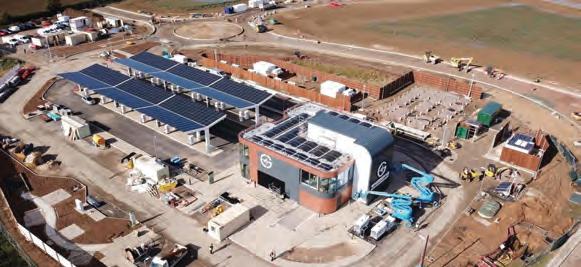
Pushing that to 100 per cent will need a lot of work, but the charging grid infrastructure could be a good starting point given the availability of better technologies to support that.
Wilson Power Solutions installed Ultra Low Loss transformers for Gridserve’s first forecourt to complement the company’s effort of decarbonising its charging infrastructures. In addition to using solar panels and battery storage, Gridserve installed Wilson e3 transformers, the UK’s most energy efficient transformers. This will ensure the company saves annually over 44GWh and 10.2 tCO2 emissions once fully operational. 1000kVA Wilson e3 Ultra Low Loss transformers save annually 19,415 kWh of electricity, 4.5 tCO2 emissions and £2,912. This can result in an additional 54,901 EV miles (medium-sized vehicle) annually to an existing charging infrastructure without spending more money, consuming more energy or emitting more carbon.

Batteries & Energy Storage
For further information on AceOn Group visitwww.eibi.co.uk/enquiriesand enter ENQUIRY No. 137
Alex Thompson is sales director at AceOn Group
Fully charged and ready

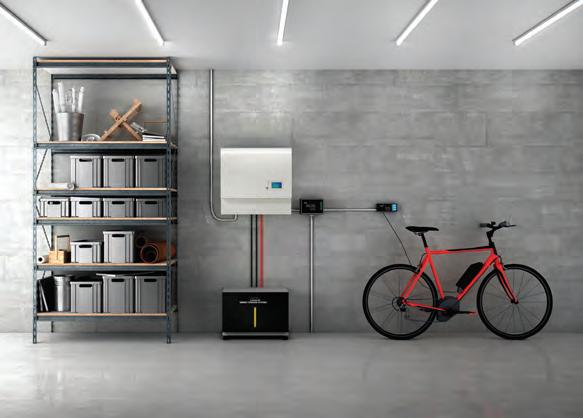
Alex Thompson explains what hurdles will need to be overcome if energy storage is to transform our relationship with renewable power
The promise to achieve net zero carbon emissions in the next 30 years is an ambitious target and one that will require a huge step change in the way we consume energy across all aspects of our personal and working lives. It will also require a big change in the way we generate and use electricity. The widespread use of energy storage batteries in residential and commercial applications will be essential.
Renewable energy generation is variable and difficult to control and unless we can store the power we generate, we will struggle Good connection: but the cost of installing an to balance a 100 per cent green energy storage solution is currently quite high electricity supply with the peaks and troughs of end-user demand. councils and housing associations service providers for unused Currently on average just 20 to meet their overarching carbon ‘green’ electricity. per cent of electricity generated reduction targets, fitting energy As larger battery solutions come on a traditional domestic solar storage batteries in affordable onboard, there are commercial PV system is consumed on the and social housing can reduce and industrial opportunities too. premises. electricity bills for tenants. Also, These end users often consume
This is where energy storage when added to AceOn’s Renewergy a majority of the electricity they batteries can help as they virtual power plant (VPP), they generate during the day from roof harness the power generated by can generate extra revenue, as the panels, so a storage battery could renewable generators (from solar combined spare capacity of all of be used to provide back-up power panels to wind turbines), and the batteries installed in the VPP or emergency lighting in the event allow the electricity to be used can be aggregated together and of an outage, and to generate more efficiently by consumers. traded with the grid. additional income for the business They can also provide a smart when it’s closed. resource which can be used by the Additional income There is no doubt that the Electricity System Operator (ESO) Energy storage technology can also installation of energy storage to balance and stabilise the grid. be used in private houses, where batteries can help the UK deliver a
Thanks to the global adoption homeowners benefit from lower net zero carbon future, but there of renewables and the continued energy bills and an additional are challenges to be overcome if we electrification of infrastructure, the income from grid servicing if they are to realise its full potential. Consortium for Battery Innovation choose to be part of the VPP and Like any innovative technology (CBI) estimates that demand for also the Smart Export Guarantee in its infancy, the cost of buying battery energy storage will jump (SEG), which is paid by energy and installing an energy storage up to 400,000MWh in the next 5 years alone (compared to 100,000 in 2015).
Interest is being driven by public sector demand for more energyefficient local authority and social housing. AceOn has recently signed partnership agreements with the Association for Public Service Excellence and the National Housing Federation to provide information and advice to their members.
This is because as well as helping solution is currently quite high and the payback times are towards the end of the product life cycle, however extra revenue generated from grid servicing as part of the VPP can reduce this payback period. To make them a more attractive prospect, the Solar Trade Association is pushing the Government for financial support for storage batteries, perhaps as part of the Chancellor’s Greener Homes commitment.
As it is a new technology, we need to build confidence in the market and this will come through information and education. We are increasingly seeing companies that normally sell solar panels and inverters now selling batteries but not all have the necessary specialist expertise. This can result in misleading claims which can confuse and potentially disappoint the end user. For example, “unlimited cycles over 10 years” – no battery has unlimited cycles.
To combat false claims and crude kWh per £ calculations, AceOn would like to see more robust metrics used to compare different energy storage batteries, focusing on how much energy a battery delivers over a sustained period so people can see what they are getting for their investment. Some batteries, even those from world-leading brands, run at 96 per cent depth of discharge, therefore putting the li-ion cells under extreme stress which can shorten the lifespan of the battery.
To make sure consumers get both value and performance, it’s certainly worth buying from an established, reputable battery manufacturer. Unfortunately, there are many cheap imported batteries appearing on the market and many have very low charge rates, meaning they can’t get charge into the battery quick enough, so excess energy generated by the solar panels goes back to the grid rather than to the battery.
There is so much anticipation for the arrival of energy storage batteries in the UK, and if we approach it right, this tech has the potential to transform how we integrate renewable power into residential, commercial and industrial installations and help us achieve a carbon zero future.
Vilnis Vesma is a former energy manager and a specialist advisor on energy monitoring and targeting
Energy in Education
For further information on Vilnis Vesma visitwww.eibi.co.uk/enquiriesand enter ENQUIRY No. 129
Buildings with two personalities
Many buildings in the education estate change character between term and vacation times. So how do you analyse building performance? Vilnis Vesma explains how
Routinely comparing actual and expected energy consumption is fundamental to good energy management.
It is the foundation of exception reporting and of cusum analysis (an important diagnostic tool) as well as being the key to meaningful performance indicators. And the more accurately you can estimate
‘expected’ consumption, the better you can do those things. But buildings in the education estate present a particular challenge because many of them change personality between term-time and vacations, in a way that distorts or even defeats the analysis of performance. In this article I suggest a couple of fixes for this problem.
I will start with the more difficult challenge first: monitoring the fuel used for heating. At the risk of repeating basic ideas that most readers will be familiar with, expected fuel consumption in any given week1 will consist partly of a constant ‘base load’ overlaid with a variable, weather-dependent quantity which is usually proportional to the measured degree-day value for the week. For those unfamiliar with them, degree days are simply a measure of how cold the weather has been, in aggregate over the week, relative to the outside temperature at which no heating is required. For an idea of how they are calculated see
Fig. 1. The degree-day value is the blue shaded area bounded by the outside-air temperature trace and the base temperature. Anything which increases the blue area— lower temperatures or longer duration of low temperature—will increase fuel demand in proportion to the increase in area.
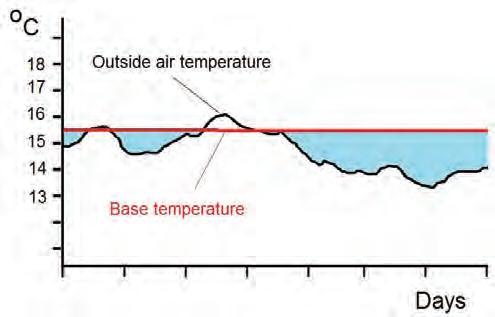
Weekly degree-day figures can be obtained from various sources. The essential point is that having once established the linear relationship between a building’s fuel consumption and local degreeday figures, we can use subsequent degree-day values to calculate what the consumption should have been.
Common base temperature With most buildings one would do the assessment against degreedays calculated to one common base temperature (Fig. 1 used the common UK default of 15.5oC). However, this will over-estimate expected consumption when the building is closed and running with a reduced level of heating, because it assumes normal occupancy. To get around this we can substitute different degreeday values during unoccupied weeks, using values calculated to a lower base temperature. Fig. 2 shows how. The table shows three degree-day histories. One is computed to a base of 15.5oC and the second, derived from the same temperature data, to base
Figure 1: the degree-day value is the time integral of temperature deficit below base.
10oC. The third (‘moving base’) column mixes the two. If it was a vacation week it uses the 10oC value; otherwise the 15.5oC value. Using this kind of modified degreeday history should give better correlation with fuel consumption and—importantly—if somebody leaves the heating running at the start of the winter vacation it will now show up as an exception which can be accurately quantified and costed.
For loads which are not weather dependent (such as general electrical supplies) a different
Figure 2: the moving-base degree-day series picks the weekly degree-day value appropriate for the prevailing level of heating
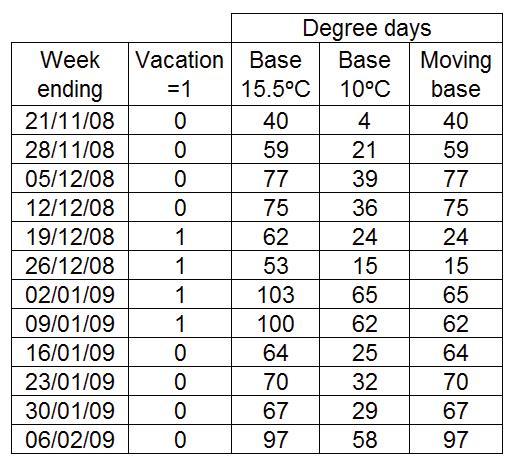
approach can be used in which expected weekly consumption toggles between ‘occupied’ and ‘unoccupied’ constant values. Looking at Fig. 2, there is a column containing zeroes and ones, with the latter indicating vacation. The formula for expected consumption can be derived from regression analysis using this binary value as the independent variable.
There is a third strategy and that is to treat the occupied and unoccupied manifestations of the building as if they were two distinct installations. Hence for analysis purposes you would set up two histories, recording data only for term-time weeks in one of them, and only for vacation weeks in the other. Each history would have its own formula for expected consumption. You could be forgiven for asking whether this is this legitimate because when we learn about time-series analysis such as control charts and cusum we are told that the observations need to be chronological and at equal intervals. However, there is nothing to say the observations absolutely have to be sequential. It is quite acceptable for there to be a gap which is closed up so that the first week of one term immediately follows the last week of the previous term in our charts. And why not? We would expect performance to be the same after the vacation as it was before.
This third strategy is applicable in other scenarios. For example, in a food processing plant with automatic meter reading which has daytime production shifts and devotes the nights to cleaning in place, every consumption stream should have separate daytime and night-time histories. Estimates of expected consumption will be all the more accurate, and energy or water waste which may manifest itself selectively during either production or cleaning operations—or under all conditions—will be all the easier to discern.
Reference 1) Weekly analysis and reporting is my recommended default for serious routine energy analysis. The method described here is impractical at monthly intervals.

eibi.co.uk/enquiries Enter 12

Karl Walker is market development manager at Beckhoff Automation
Energy in Education
For further information on Beckhoff Automation visitwww.eibi.co.uk/enquiriesand enter ENQUIRY No. 130
Let the students take the lead
Karl Walker explains how the latest advances are prompting the next generation to think more carefully about energy efficiency in their schools, colleges and universities
Schools, colleges and universities are searching for new ways to empower students and spark an interest that will last a lifetime, or at least start them down the road towards a fulfilling career where they can feel like they can make a real difference. Traditionally, this may have been achieved by passing on knowledge and expertise through textbooks and lectures but there is now a move towards combining this method with one that promotes a more ‘hands on’ approach, handing responsibility directly to the student and trusting them to make their own realworld decisions with the help of technology.
A clear example of this is in the educational establishments that have given their students the opportunity to manage energy performance within the walls of the campus. With an acute awareness of the need for environmental change, the current generation of students – often referred to as ‘Generation Z’ by the media – recognise the urgent requirement to reduce CO2 emissions before the feared ‘tipping point’ is reached. By providing these young people with easy-to-understand charts, building layouts and reports, energy consumption is clearly visible and they are given the opportunity to learn first-hand about energy usage and come up with ways to reduce waste.
In order to facilitate this practical approach to energy efficiency education, an integrated approach to building services is required.
Building control services, often supplied by different vendors and manufacturers, tend to grow and change over time using a variety of communication interfaces and protocols. These systems are rarely integrated; for example, HVAC, DHWS and lighting controls will generally be independent of each other. Interoperable technology can integrate with existing building controls and securely transfer
Students are being given the opportunity to manage the energy performance of their campus

data to the cloud service using the lightweight MQTT messaging protocol.
At a local level it is possible to utilise numerous communications protocols, including BACnet, Modbus, M-Bus, DALI and KNX, to provide a supervisory control layer which normalises and centralises services within the BEMS platform. Highly expandable technology also provides the backbone for growth with the option to add more building controls and physical IO.
‘Pane of glass’ view Supervisory control solutions offer a transparent ‘single pane of glass’ view of a building’s systems and a gateway integrates with building control systems and sensors, securely transferring building operation data to a cloud service.
By analysing a building’s energy consumption against its control strategy, the BEMS can identify anomalies in a building’s operation,
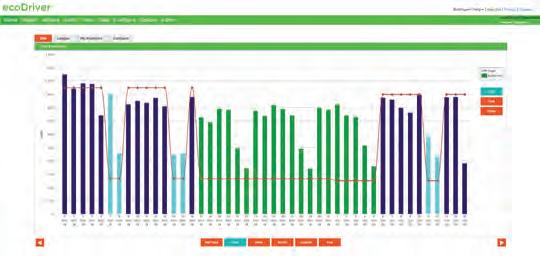
modify as appropriate so that the building operates within its ‘sweet spot’ and maintain the optimised performance level to retain savings.
Schools, colleges and universities are coming under intense pressure to deliver cost savings at every possible opportunity, therefore the traditional ringfencing of utilities is increasingly becoming an unrealistic prospect.
With a newly installed BEMS in place, savings of between 10-51 per cent can be achieved, dependent on the existing set-up. In one recent example, the school’s actual energy consumption was three times higher than the building design estimate. There was no visibility of consumption profiles for the local premises team, and the BMS schedules, setpoints and exceptions had not been configured correctly. To resolve these issues, automated main meter data capture and reporting was integrated using the BEMs, which subsequently allowed energy profiles to be displayed, reviewed and modified accordingly. A systematic approach to energy reduction was also implemented, which enabled the local premises manager to modify schedules and setpoints. The result was a 41 per cent energy saving in less than four months.
Taking responsibility for energy performance at their own school, college or university offers students valuable life experience at an early age and will prepare them for the challenges they may face in their future careers.
This is a point made by Richard Dunne, a former headteacher who founded the Harmony Project in 2018. The Harmony Project recognises the impact of human activity on the natural world, and humankind’s increasing disconnection from nature. Education is one of the sectors in which Richard has applied Harmony and he believes that by rethinking environmental education so that it is at the heart of learning, schools can encourage their students to actively engage with pressing environmental issues at the same time as teaching them valuable life skills.
Dunne says: “For the most part, sustainability in education is seen as an add-on. It might be presented as a one-off environmental day or eco week. It will almost certainly be presented outside of the formal curriculum. It may engage the interest of a good many students, but the mere fact that it is not integrated into the broader curriculum means that the opportunities to link learning together are unlikely to be explored.”
It’s becoming clear that drastically reducing the carbon footprint of commercial buildings will be a crucial battle in the fight against climate change. With the technology now available to them, today’s students really can play a leading role in managing their own environment at a local level, and this will have positive repercussions on a regional, national and even global scale - the children are building their own future.
Energy in Education
For further information on Airflow Developments visitwww.eibi.co.uk/enquiriesand enter ENQUIRY No. 131
Lucy Holland is marketing executive at Airflow Developments
Effective ventilation is essential for students to maintain concentration

Stay sharp in the classroom
It’s not easy concentrating in a stuffy classroom. Lucy Holland discusses how a ventilation strategy is so important for energy managers working in the education sector
Ventilating a classroom there are constant air changes in classroom, children work faster and is just as important as the classroom. There is a constant are better at solving tasks. When ventilating your home, stream of fresh air circulated and 30 children are in one room there if not more. With up to polluted stale air is extracted from will be extremely high levels of CO2, 30 pupils in one room, the room. often exceeding the CIBSE guidelines you can only begin to imagine how It is known fact that poor indoor maximum of 1,500ppm. This will polluted the air quality is. Effective air quality is linked to many directly affect the performance and ventilation is paramount, it will not health conditions. The build-up attention span of those in the room, just improve the quality of air, but of pollutants and Volatile Organic causing tiredness, drowsiness, and a will also increase concentration and Compounds (VOCs) contribute to lack of concentration. Longer-term productivity levels of the students. highly polluted air that is inhaled by exposure to polluted air can also lead This is crucial for protecting the students and teachers. to headaches, irritation of nose and health and wellbeing of the pupils throat, and coughs. and teachers. Trapped in classrooms • Filtration: Mechanical ventilation
Here are five reasons ventilation Cleaning products, sprays and glue units have in-built filters, that in classrooms are essential for are just some of the contributors not only filter the air that is being everyone: to the poor atmosphere found exhausted, but the air that is being • Air Quality: Children stay in trapped in classrooms. Installing a brought in from outside. High grade classrooms for long periods of ventilation system can help reduce filters ePM10 70 per cent (F7) are in time. However, classrooms often the pollutant build up by removing place on the supply air in. Although have insufficient ventilation. toxic air. we refer to ‘fresh air’ as the air This negatively impacts a child’s • Concentration: It can be difficult coming in from outdoors, how fresh concentration levels and ability to to concentrate in a stuffy classroom. do you really think it is? learn. Effective ventilation ensures But in a properly ventilated Depending on your location and distance from towns, cities and busy roads, the air pollution differs. Filtering the air coming into the classroom ensures pollution levels are minimised and ‘fresh air’ really is coming in. • Control. The great thing about mechanical ventilation is that not only does it let you control your indoor environment, but it also contributes to the temperature of the room.
Mechanical Ventilation with Heat Recovery units transfer the heat from the extracted air across to the incoming air without any cross contamination. This means the heat is retained in the classroom whilst the air is being ventilated. Adding a CO2 sensor to the system provides demand control ventilation, meaning the supply and extract flows ramp up and down according to the CO2 levels. • Building Regulations: Ventilation is also essential to comply with the latest building regulations and guidelines which include: Part F & L; Non-Domestic Building Services Compliance Guide and Ventilation and Indoor Air Quality in Schools; and Building Bulletin 101 and 93 (BB101 & BB93).
The UK government introduced BB101 Guidelines on Ventilation, Thermal Comfort, and Indoor Air Quality in Schools to ensure that when schools are built and renovated, they provide a healthy indoor air environment for every student.
Adjusting on demand Airflow offers a ceiling-mounted heat recovery solution for classrooms, offices, and conference rooms - the Sussuro. The Susurro’s integral CO2 sensor actively monitors the indoor air quality inside the room or office and enables the unit to automatically adjust its ventilation based on occupant demand; maintaining a healthy, fresh indoor air environment without the occupants having to open a window. By maintaining healthy CO2 levels, Susurro is claimed to improve concentration and productivity levels of students and employees, lowers occupant fatigue, decreases the risk of long-term health issues, and reduces the number of days lost due to illness.
Vincent de Rul is director of EV Solutions at EDF
Electric Vehicles
For further information on EDF visitwww.eibi.co.uk/enquiriesand enter ENQUIRY No. 150
An EV strategy must be included within a much larger energy system

Managing site capacity
For businesses looking to begin their transition to EVs, Vincent de Rul urges businesses to consider the management of site capacity when creating their charging infrastructure plans
Transport is the UK’s largest all need to be factored into the example, reducing the load for contributor to greenhouse planning process. charge points where vehicles have gas (GHG) emissions and Having an understanding of your been plugged for longer to ensure is a key area of focus for on-site charging requirements will, that those with the least amount net zero initiatives. The UK in turn, help to inform whether or of charge can catch up. This type of Government has been seeking views not you have sufficient electrical system can also be programmed to on bringing forward the end to the capacity or whether you may need identify “VIP” charge points – so, if sale of new petrol, diesel and hybrid to consider workarounds. If there is for example an emergency vehicle cars and vans from 2040 to 2035, enough capacity from the existing parks in a chargepoint bay, they will or earlier if a faster transition looks supply, no network reinforcement be prioritised for charging – by using possible. will be required. However, if any VIP RFID card.
For those organisations developing reinforcement is needed, it will be By using LMS to balance the their EV strategy and looking to your local DNO who will provide this. load, your business can ensure that understand the EV eco-system (see additional charging processes don’t diagram) it’s useful to consider this Minimise additional investment cause the connection capacity to be as a component within a much So how can businesses minimise exceeded, saving you additional grid larger energy system which includes additional infrastructure investment? expansion and operating costs. not only the EV, chargepoints and In the first instance, and dependent First and foremost, energy supporting technologies (such as on charging requirements, businesses efficiency should be at the top of Vehicle-to-Grid) but also gives wider should look to optimise the use the agenda for any organisation consideration to crucial elements like of chargepoints through a Load working to support the UK’s net power supply, energy efficiency and Management System. There are two zero ambition. Optimising energy storage, as well as the management of types of system: static and dynamic. use on site will also ensure better, these through flexible systems. A static load management system more efficient use of the capacity
Once you’ve begun developing evenly distributes power for all that is already available. an EV strategy and identified your charging stations across several Using on-site generation like requirements for a vehicle transition connected EVs, no matter how many solar or wind assets, to power your plan, you’ll also need to create a of the individual EVs are charging. chargepoints could be a solution to charging infrastructure plan. Mapping Each charging station is allocated the capacity constraints. This energy and overlaying your requirements same charging power. can then be used on-site, reducing onto vehicle leasing or procurement In contrast, a dynamic load the imported energy demand and/ cycles will help to inform charging management system can or earning revenues from flexibility infrastructure requirements. Charging intelligently reduce and divert the services (like EDF’s PowerShift). speeds, energy contracts and capacity power to where it’s needed. For If coupled with a battery, this technology can offer significant savings potential.
Using new technology such as V2G chargers can present another opportunity for managing capacity and costs. By charging your V2G-capable vehicles when your import energy is cheap (e.g. overnight or from a generation source such as solar/wind) and discharging from the car back into the site when energy costs are at their peak (typically 4-7pm) the need to import expensive power can be avoided. By utilising the EV to power your site, you can avoid having to import as much energy as you would normally. This reduces the maximum demand drawn from the grid, and can avoid the need to pay for costly reinforcement or additional KVA.
Taking this approach will require careful management of fleet. It will call for the vehicles to be parked, charged and available to be utilised during the peak hours of 4-7pm weekdays (and potentially other times). A single vehicle’s storage only offers a short timescale before the energy is depleted and needs to be recharged. So, multiple vehicles would be required to truly benefit from V2G in a commercial environment.
Battery storage as a solution could take the form of direct connection to a grid-scale battery storage network (like the type of project that Pivot Power, part of EDF Renewable, is developing in the UK) or utilisation of smaller scale on-site battery assets.
Smaller scale on-site battery assets allow you to charge your battery when your import energy is cheaper and discharge from the battery when energy costs are at their peak, helping you to avoid the need to import expensive power from the grid.
Utilising battery storage in this way reduces the maximum demand being drawn from the grid, and can avoid the need to pay for costly reinforcement or additional KVA. This also offers a temporary resilience against outages to the main incoming supply.
At EDF, our team can support you in defining the best options to electrify your fleet and identify your site capacity requirements. We’ll help you in navigating and implementing the option that’s right for you, as well as defining the right EV charging infrastructure. • https://www.edfenergy.com/electric-cars/ business/consult
Energy in Education
For further information on products and services visit www.eibi.co.uk/enquiries and enter the appropriate online enquiry number
Software helps cut energy use by 33%
Since 2000, Texas Tech University in Lubbock, Texas, has lowered its energy budget by $6m and reduced its energy use index by 33 per cent. And this at a time when the campus has grown by 186,000m2 and student population has increased by 63 per cent.
Texas Tech has implemented the eSight energy management software (EMS) as a means of effecting a transition from reactive maintenance to persistent commissioning. Reactive maintenance is the practice of correcting equipment failures after they make themselves known. Persistent commissioning is identifying failures as or even before they occur and taking immediate action to restore as-new performance.
Texas Tech searched for a customisable EMS that harvests realtime energy data to quickly identify energy savings opportunities and improve the response time of repairs. They needed a modular, scalable solution that was rich in analytic capabilities and low in initial cost of implementation.
Texas Tech selected eSight for many reasons: eSight provides an abundance of user- friendly analytical tools, particularly CUSUM analysis, and modular features that are not offered by any other software. The modularity and scalability of eSight allowed Texas Tech to design a low-cost pilot project and implement the innovation by integrating existing meters before investing in new meters.
During the pilot, eSight Energy worked with several control companies and Texas Tech’s Energy Management Team to integrate data from a select few meters into the eSight platform. In addition to the industry-leading analytics of eSight, the ease of deployment and low initial costs provided a quick return on investment.
On the day the eSight Energy EMS was powered up in July 2015 (FY15), it identified a $220,000 savings opportunity in the English/Philosophy building, on which Texas Tech quickly capitalised. In the second year (FY16), similar corrections produced savings of over $500,000.
Since that return on such a lowcost implementation, Texas Tech has integrated meters from 49 buildings with plans to expand to 200 buildings over the next several years. ONLINE ENQUIRY 135
Massachusetts university looks to optimise air handling units

The creation of the University of Massachusetts Medical School’s $400m Albert Sherman Centre, has brought about a new era of biomedical research, medical education and campus collaboration. Standing eleven storeys high, with nine occupied floors topped by a two-storey mechanical penthouse, the facility includes research laboratories, six learning community centres, a 350-seat auditorium, conference rooms, a full-service café and dining area and a fitness centre.
If collaboration is a key output of the centre’s work, it was also a watchword in its construction, which was driven by the needs of the University of Massachusetts Building Authority, responsible for the installation and operation of the building’s cooling system. Also crucial was the ability of Konvekta AG, a Switzerland-based developer and provider of high-performance energyrecovery systems, to meet those needs.
Konvekta determined that the Sherman Centre would require two dedicated air-handling units to ensure satisfactory cooling during summer extremes. Reviewing which type of heat exchanger would efficiently recover the heat generated when the two air-handling units were operating, Konvekta chose brazed plate heat exchanger (BPHE) technology.
The design and performance of BPHEs distinguish themselves from competing technologies such as gasket plate heat exchangers. They are constructed in such a way as to allow media at different temperatures to come into close proximity and enable heat or cold to be transferred from one media to the other very efficiently. Other advantages that BPHEs provide include their compact size, flexible installation, self-cleaning operation and lower life-cycle cost.
For the air-handling units at the Sherman Centre, Konvekta commissioned two SWEP B50H BPHEs. Simon Buehler, sales manager for Konvekta, said “SWEP B-type heat exchangers are able to optimise energy use, material and space in cooling systems. They are compact, less costly than other solutions, durable and have high heat-transfer performance.”
ONLINE ENQUIRY 134
New boilers mark school’s 600th anniversary
Boilers and water heaters from Lochinvar are playing an important part in a project designed to mark the 600th anniversary of one of the country’s oldest schools.
The Royal Latin School was founded in 1423 to teach boys the ‘Trivium’ (Latin grammar, logic and rhetoric) in Buckingham. It received royal status in 1597, at which time it was required to teach six boys, and it started admitting girls in 1907.
It has subsequently moved to two different sites with its current campus opened by the Queen Mother in 1963. As its 600th anniversary approaches, the school has embarked on an ambitious three-phase development programme to provide a new science laboratory, which was recently opened by Professor Robert Winston, a sports campus and to substantially upgrade many of its other facilities.
Lochinvar provided three Herald boilers along with two EcoCharger water heaters as part of a major plant room refurbishment to provide the required amount of heating and hot water for the main school building including classrooms, dining hall, assembly hall, offices and kitchen. These high performance, energy efficient products were installed to replace ageing cast iron boilers and atmospheric water heaters.
Stainless steel is an increasingly
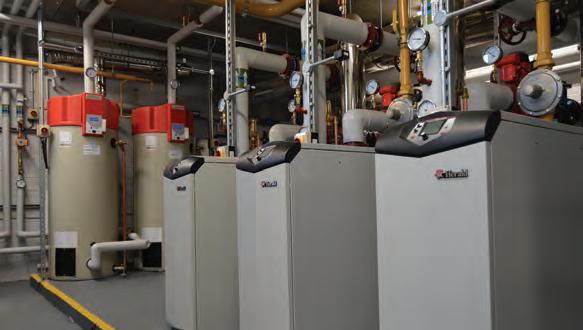
popular material with specifiers because of its ability to resist corrosion of up to 11 bar and can deliver temperatures up to 88oC at Delta T of 30oC.
Lochinvar also supplied two CPM wall-hung gas fired boilers in 2018, which continue to provide heating for one of the school’s other buildings.







